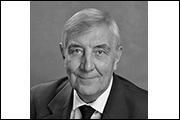John Laird Telford, former member of the EMBL Developmental Biology Unit, died on 27 December 2020 at the age of 70.
We are deeply saddened to share the news of the loss of John L Telford. John was a scientist in the EMBL Developmental Biology Unit from 1979 to 1984. In addition to his contributions to the molecular biology of Drosophila development, John was an active member of the EMBL community, which he introduced to Burns night celebration and Scottish country dancing. He moved to Siena with his family in 1984, shifting to vaccine research at Sclavo Research Center, where he made seminal discoveries in the area of infectious disease that led to the development of new vaccines. He is profoundly missed by his wife and EMBL Alumnus (Cosima) Tatiana Baldari, who he met at EMBL, his three children Andrew, Marco and Erica, his granddaugther Mia, and his friends and colleagues worldwide. May he rest in peace.
(Cosima) Tatiana Baldari (EMBL Heidelberg Postdoc, Pirrotta Group, 1978-1980)
It is difficult, only a few weeks from his death, to write about the person who loved me, supported me, shared with me my most wonderful and most distressing experiences alike for the last 42 years of my life. I met John in 1979, when we both joined Vince Pirrotta’s newly founded lab at EMBL, he from Max Birnstiel’s lab in Zurich, I from Francesco Amaldi’s lab in Rome. It was love at first sight. John was handsome, funny, self-confident, full of life. He loved socialising, dancing, listening to music, reading, exploring the world. He was fiercely attached to his roots, proud to be a Scot -and you could not be mistaken when you heard him talk!
John loved science, the more challenging, the best. He had magic hands. In Max’s lab he was the one who achieved the impossible task, in these early days of recombinant DNA technology when the only genes that could be easily isolated were those for rRNA, to clone the first protein-coding genes -the histone genes of sea urchin. I still remember his gels, the most perfect I have ever seen, his rich cDNA libraries, his amazingly long reads in Maxam-Gilbert sequencing, his super-efficient [P32] labelings for fantastic hybridisations. To these technical qualities he flanked a keen scientific curiosity and an amazing capacity of observation which were instrumental to his major discoveries during his career in Siena, where he joined the Sclavo Research Center which in the following years underwent several changes of hands to eventually become Novartis Research Center, headed by Rino Rappuoli. There, after his initial years of seminal studies on T cell signaling, he shifted to the main focus of his career, the study of pathogens for the development of new vaccines. He cloned the gene encoding the Helicobacter pylori vacuolating cytotoxin VacA and provided critical insight into its mechanism of action and role in gastric disease. With his research on group A and B Streptococcus he discovered that gram-positive bacteria assembly pili, providing an identity to the elusive “T antigens” described decades before by Rebecca Lancefield. Based on this ground-breaking discovery, his group characterized the composition and mechanism of assembly of these pili in a collaborative effort with other units at Novartis, setting the stage for the development of a vaccine against these pathogens.
John was not only an inspired and inspiring scientist, but also a wonderful mentor. He loved training his young team members in all facets of science, from identifying a relevant question to developing a research plan, to scrupulously executing the experiments, to critically interpreting the results. In his training he gave major weight to scientific communication, whether writing a crisp, beautifully articulated paper, or a compelling research proposal, or a presentation to both specialised and lay audiences. He supported young, promising scientists to enhance their career progression, and was always ready to fight to help women scientists to break science’s glass ceiling. I am sure that the scientific community will miss him. I have received so many messages from his former colleagues underscoring his value as a scientist as well as his qualities as a warm and generous human being.
John was able to combine a demanding career as a scientist with a complete dedication to his family. To me, he was a wonderful, caring husband who made it possible for me to develop a successful career by giving me his unconditional support. In several instances he favoured my opportunities over his and stepped back to enhance my visibility, as for the Siena EMBO conference series of which he was a founder. He gave me self-confidence, supported my choices and shared with dedication the duties of growing up our three children, giving them a warm and happy home despite our very busy professional lives. He was there for me whenever I needed him and was always ready to tell everybody how wonderful I was. He made me a better person. To our children he was a loving and supportive father. He was so proud of them, as I am. He made our life happy and worthy. We miss him so much. He will always live in our hearts and our memory.
Condolences If you would like to add a message of condolence for inclusion on this page, please contact the Alumni Relations team.
